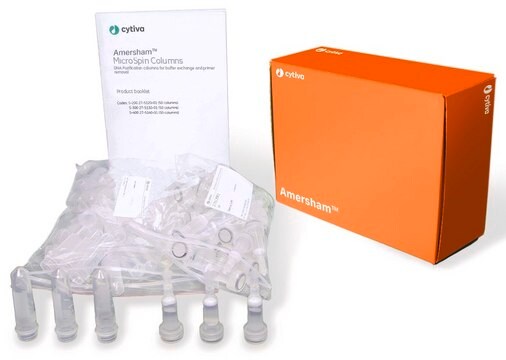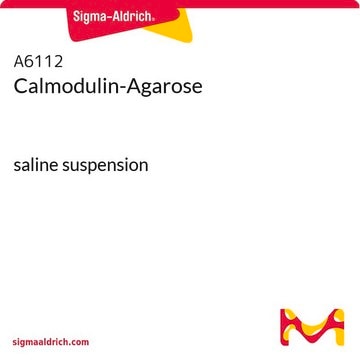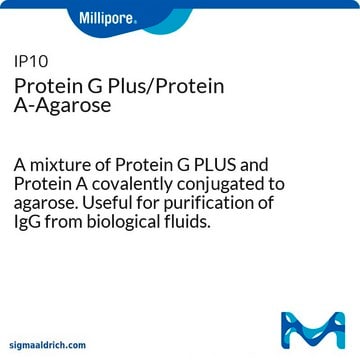U5632
Ubiquitin−Agarose
saline suspension
Iniciar sesiónpara Ver la Fijación de precios por contrato y de la organización
About This Item
Productos recomendados
formulario
saline suspension
Nivel de calidad
Extensión del etiquetado
7-15 mg per mL
técnicas
affinity chromatography: suitable
matriz
Fast flow highly cross-linked 4% beaded agarose
espaciador de matriz
6 carbon
temp. de almacenamiento
2-8°C
Aplicación
Ubiquitin-agarose is used in affinity chromatography, protein chromatography, intracellular protein degradation, calpain and lysosomal proteases, proteomics, specialty resins and ubiquitination analysis. Ubiquitin-agarose has been used in a study to produce evidence for a particulate location of ubiquitin conjugates and ubiquitin-conjugating enzymes in the rabbit brain. Ubiquitin-agarose has also been used to study fertilization of the ascidian, Halocynthia roretzi.
Forma física
Suspension in 1 M NaCl containing 15 Mm Sodium azide.
Código de clase de almacenamiento
10 - Combustible liquids
Clase de riesgo para el agua (WGK)
WGK 3
Punto de inflamabilidad (°F)
Not applicable
Punto de inflamabilidad (°C)
Not applicable
Equipo de protección personal
Eyeshields, Gloves
Certificados de análisis (COA)
Busque Certificados de análisis (COA) introduciendo el número de lote del producto. Los números de lote se encuentran en la etiqueta del producto después de las palabras «Lot» o «Batch»
¿Ya tiene este producto?
Encuentre la documentación para los productos que ha comprado recientemente en la Biblioteca de documentos.
Anjali Joshi et al.
Traffic (Copenhagen, Denmark), 9(11), 1972-1983 (2008-09-27)
Retroviral Gag polyprotein precursors are both necessary and sufficient for the assembly and release of virus-like particles (VLPs) from infected cells. It is well established that small Gag-encoded motifs, known as late domains, promote particle release by interacting with components
Shin-Chung Kang et al.
The Journal of pathology, 203(1), 603-608 (2004-04-20)
Although the key event in the pathology of prion diseases is thought to be the conversion of cellular prion protein (PrP(C)) to the protease-resistant scrapie species termed PrP(Sc), the factors that contribute to neurodegeneration in scrapie-infected animals are poorly understood.
M Majetschak et al.
European journal of biochemistry, 255(2), 482-491 (1998-08-26)
Ubiquitin is often implicated as a specific tag for protein degradation via the ubiquitin system although only a limited number of physiological proteins have been shown to be degraded in their native tissues via this pathway in vivo. Ubiquitin may
A Ciechanover et al.
The Journal of biological chemistry, 257(5), 2537-2542 (1982-03-10)
We have previously described an enzyme that activates ubiquitin, the heat-stable polypeptide of the ATP-dependent proteolytic system from reticulocytes (Ciechanover, A., Heller, H., Katz-Etzion, R., and Hershko, A. (1981) Proc. Natl. Acad. Sci. U. S. A. 78, 761-765). It carries
M Hoefer et al.
FEBS letters, 289(1), 54-58 (1991-09-02)
Ubiquitin-activating enzyme was purified from the yeast Saccharomyces cerevisiae by covalent affinity chromatography on ubiquitin-Sepharose followed by HPLC anion-exchange chromatography. Enzyme activity was monitored by the ubiquitin-dependent ATP: 32PPi exchange assay. The purified enzyme has a specific activity of 1.5
Nuestro equipo de científicos tiene experiencia en todas las áreas de investigación: Ciencias de la vida, Ciencia de los materiales, Síntesis química, Cromatografía, Analítica y muchas otras.
Póngase en contacto con el Servicio técnico








